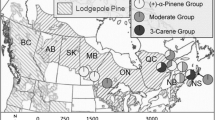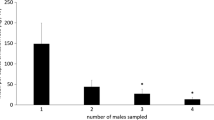Abstract
Quantities of attractive (exo-brevicomin and frontalin) and inhibitory (trans-verbenol, verbenone, and ipsdienol) pheromones were monitored in both sexes ofDendroctonus brevicomis during their colonization of a ponderosa pine. Verbenone was found in males in the greatest amounts at the time of landing, and it declined more rapidly than the other pheromones in either sex. The amounts of frontalin andexo-brevicomin in males and females, respectively, increased after initial boring within the host but began to decline after mating. The quantity oftrans-verbenol in both sexes (females had significantly more) declined more gradually thanexo-brevicomin, frontalin, and verbenone. Ipsdienol was found only in males during the initial stages of attack when encountering the resin. It is suggested that along with a general decline in all pheromonal components, a sufficient change in the ratio of the attractive pheromones to an inhibitory pheromone,trans-verbenol, may play a role in termination of aggregation.trans-Verbenol may also function along with verbenone and ipsdienol in limiting the density of attack and thus intraspecific competition. These inhibitory pheromones also appear to cause several competing species of bark beetle to avoid landing in areas infested withD. brevicomis, even when their own pheromone is present.
Similar content being viewed by others
References
Bedard, W.D., Tilden, P.E., Lindahl, K.Q., Jr., Wood, D.L., andRauch, P.A. 1980a. Effects of verbenone and trans-verbenol on the response ofDendroctonus brevicomis to natural and synthetic attractant in the field.J. Chem. Ecol. 6:997–1013.
Bedard, W.D., Wood, D.L., Tilden, P.E., Lindahl, K.Q., Jr., Silverstein, R.M., andRodin, J.O. 1980b. Field response of the Western pine beetle and one of its predators to host- and beetle-produced compounds.J. Chem. Ecol. 6:625–641.
Bedard, W.D.,Lindahl, K.Q.,Jr., Tilden, P.E., andWood, D.L 1984. Behavior of the Western pine beetle during host colonization.J. Chem. Ecol. In press.
Berryman, A.A. 1974. Dynamics of bark beetle populations: Towards a general productivity model.Environ. Entomol. 3:579–584.
Birch, M.C., andWood, D.L. 1975. Mutual inhibition of the attractant pheromone response by two species ofIps.J. Chem. Ecol. 1:101–113.
Birch, M.C., Light, D.M., Wood, D.L., Browne, L.E., Silverstein, R.M., Bergot, B.J., Ohloff, G., West, J.R., andYoung, J.C. 1980. Pheromonal attraction and allomonal interruption ofIps pini in California by the two enantiomers of ipsdienol.J. Chem. Ecol. 6:703–717.
Birgersson, G.,Schlyter, F.,Löfqvist, J. andBergstrom, G. 1984. Quantitative variation of pheromone components in the spruce bark beetleIps typographus from different attack phases.J. Chem. Ecol. In press.
Browne, L.E., Wood, D.L., Bedard, W.D., Silverstein, R.M., andWest, J.R. 1979. Quantitative estimates of the Western pine beetle attractive pheromone components,exo- brevicomin, frontalin, and myrcene in nature.J. Chem. Ecol. 5:397–414.
Byers, J.A. 1981a. Effect of mating on terminating aggregation during host colonization in the bark beetle,Ips paraconfusus.J. Chem. Ecol. 7:1135–1147.
Byers, J.A. 1981b. Pheromone biosynthesis in the bark beetle,Ips paraconfusus, during feeding or exposure to vapours of host plant precursors.Insect. Biochem. 11:563–569.
Byers, J.A. 1982. Male-specific conversion of the host plant compound, myrcene, to the pheromone, (+)-ipsdienol, in the bark beetle,Dendroctonus brevicomis.J. Chem. Ecol. 8:363–371.
Byers, J.A. 1983a. Bark beetle conversion of a plant compound to a sex-specific inhibitor of pheromone attraction.Science 220:624–626.
Byers, J.A. 1983b. Sex-specific responses to aggregation pheromone: Regulation of colonization density by the bark beetleIps paraconfusus.J. Chem. Ecol. 9:129–142.
Byers, J.A. 1983c. Influence of sex, maturity and host substances on pheromones in the guts of the bark beetles,Ips paraconfusus andDendroctonus brevicomis.J. Insect Physiol. 29:5–13.
Byers, J.A., andWood, D.L. 1980. Interspecific inhibition of the response of the bark beetles.Dendroctonus brevicomis andIps paraconfusus.J. Chem. Ecol. 6:149–164.
Byers, J.A., andWood, D.L. 1981. Interspecific effects of pheromones on the attraction of the bark beetles,Dendroctonus brevicomis andIps paraconfusus in the laboratory.J. Chem. Ecol. 7:9–18.
Cole, W.E. 1962. The effects of intraspecific competition within mountain pine beetle broods under laboratory conditions. Intermountain For. Range Exp. Stn. Res. Note No. 97, 4p.
Coster, J.E., andVité, J.P. 1972. Effects of feeding and mating on pheromone release in the Southern pine beetle.Ann. Enlomol. Soc. Am. 65:263–266.
Eidmann, H.H., andNuorteva, M. 1968. Der Einfluss der Siedlungsdichte und anderer Faktoren auf die Anzahl Nachkommen vonBlastophagus piniperda L. (Coleoplera: Scolytidae).Ann. Enlomol Fenn. 34:135–148.
Elliott, E.W., Lanier, G.N., andSimone, J.B. 1975. Termination of aggregation by the European elm bark beetle,Scolytus multistriatus. J. Chem. Ecol. 1:283–289.
Gore, W.E., Pearce, G.T., Lanier, G.N., Simeone, J.B., Silverstein, R.M., Peacock, J.W., andCuthbert, R.A. 1977. Aggregation attractant of the European elm bark beetle,Scolytus multistriatus: Production of individual components and related aggregation behavior.J. Chem. Ecol. 3:429–446.
Hughes, P.R. 1973.Dendroctonus: Production of pheromones and related compounds in response to host monoterpenes.Z. Angew. Entomol. 73:294–312.
Hughes, P.R., andPitman, G.B. 1970. A method of observing and recording the flight behavior of tethered bark beetles in response to chemical messengers.Contrib. Boyce Thompson Inst. 24:329–336.
Hughes, P.R., andRenwick, J.A.A. 1977. Hormonal and host factors stimulating pheromone synthesis in female Western pine beetles,Dendroctonus brevicomis.Physiol. Entomol. 2:289–292.
Kinzer, G.W., Fentiman, A.G., Jr., Page, T.F., Jr., Foltz, R.L., Vité, J.P., andPitman, G.B. 1969. Bark beetle attractants: Identification, synthesis and field bioassay of a new compound isolated fromDendroctonus.Nature 211:477–478.
Lanier, G.N., Claesson, A., Stewart, T., Piston, J.J., andSilverstein, R.M. 1980.Ips pini: The basis for interpopulational differences in pheromone biology.J. Chem. Ecol. 6:677–687.
Light, D.M., andBirch, M.C. 1979. Inhibition of the attractive pheromone response inIps paraconfusus by (R)-(−)-ipsdienol.Naturwissenschaften 66:159.
Mayyasi, A.M., Coulson, R.N., Foltz, J.L., Hain, F.P., andMartin, W.C. 1976. Functional description of within-tree larval and progeny adult populations ofDendroctonus frontalin (Coleoptera:Scolytidae).Can. Entomol. 108:363–372.
McNew, G.L. 1970. The Boyce Thompson institute program in forest entomology that led to the discovery of pheromones in bark beetles.Contrib. Boyce Thompson Inst. 24:251–262.
Miller, J.M., andKeen, F.P. 1960. Biology and Control of the Western Pine Beetle. U.S.D.A. Misc. Publ. No. 800, 381 p.
Nijholt, W.W. 1973. The effect of maleTrypodendron lineatum (Coleoptera:Scolytidae) on the response of field populations to secondary attraction.Can. Entomol. 105:583–590.
Ogibin, B.N. 1972. Sex ratio and size of beetles of young generation with respect to different population density ofIps typographus (Coleoptera:Ipidae).Zool. Zh. 52:1417–1419.
Payne, T.L., Coster, J.E., Richerson, J.V., Edson, L.J., andHart, E.R. 1978. Field response of the Southern pine beetle to behavioral chemicals.Environ. Entomol. 7:578–582.
Peacock, J.W., Lincoln, A.C., Simeone, J.B., andSilverstein, R.M. 1971. Attraction ofScolytus multistriatus (Coleoptera:Scolytidae) to a virgin-female-produced pheromone in the field.Ann. Entomol. Soc. Am. 64:1143–1149.
Pianka, E.R. 1976. Competition and niche theory, in: R.M. May (ed.). Theoretical Ecology Principles and Applications. Blackwell, London, pp. 114–141.
Pitman, G.B., andVité, J.P. 1974. Biosynthesis of methylcyclohexenone by male Douglas-fir beetle.Environ. Entomol. 3:886–887.
Pitman, G.B., Vité, J.P., Kinzer, G.W., andFentiman, A.F., Jr. 1969. Specificity of population-aggregating pheromones inDendroctonus.J. Insect Physiol. 15:363–366.
Reid, R.W. 1963. Biology of the mountain pine beetle,Dendroctonus monticolae Hopkins, in the east of Kootenay region of British Columbia. III Interaction between the beetle and its host, with emphasis on brood mortality and survival.Can. Entomol. 95:225–238.
Renwick, J.A.A. 1967. Identification of two oxygenated terpenes from the bark beetles,Dendroctonus frontalis andDendroctonus brevicomis. Contrib.Boyce Thompson Inst. 23:355–360.
Renwick, J.A.A., andVité, J.P. 1970. Systems of chemical communication inDendroctonus. Contrib.Boyce Thompson Inst. 24:283–292.
Rudinsky, J.A., andMichael, R.R. 1972. Sound production in Scolytidae: Chemostimulus of sonic signal by the Douglas-fir beetle.Science 175:1386–1390.
Silverstein, R.M., Rodin, J.O., andWood, D.L. 1966. Sex attractants in frass produced by maleIps confusus in ponderosa pine.Science 154:509–510.
Silverstein, R.M., Brownlee, R.G., Bellas, T.E., Wood, D.L., andBrowne, L.E. 1968. Brevicomin: Principal sex attractant in the frass of the female Western pine beetle.Science 159:889–891.
Stephen, F.M., andDahlsten, D.L. 1976. The temporal and spatial arrival pattern ofDendroctonus brevicomis in ponderosa pine.Can. Entomol. 108:271–282.
Svihra, P. 1972. Population dynamics ofIps typographus in the upper Hronec region.Ved. Pr. Vyzh. Ustavu Lesn. Hospod. 18:227–258.
Vité, J.P., andRenwick, J.A.A. 1970. Differential diagnosis and isolation of population attractants.Contrib. Boyce Thompson Inst. 24:323–328.
Vité, J.P., Bakke, A., andRenwick, J.A.A. 1972. Pheromones inIps (Coleoptera:Scolytidae): Occurrence and production.Can. Entomol. 104:1967–1975.
Wood, D.L., Browne, L.E., Ewing, B., Lindahl, K., Bedard, W.D., Tilden, P.E., Mori, K., Pitman, G.B., andHughes, P.R. 1976. Western pine beetle: Specificity among enantiometers of male and female components of an attractant pheromone.Science 192:896–898.
Author information
Authors and Affiliations
Additional information
Coleoptera:Scolytidae. These studies were supported in part by the Rockefeller Foundation, USDA Forest Service, Regional research project W-110, SEA/ USDA, and the National Science Foundation and Environmental Protection Agency through a grant (NSF GB-34719/BMS 75-04223) to the University of California.
Rights and permissions
About this article
Cite this article
Byers, J.A., Wood, D.L., Craig, J. et al. Attractive and inhibitory pheromones produced in the bark beetle,Dendroctonus brevicomis, during host colonization: Regulation of inter- and intraspecific competition. J Chem Ecol 10, 861–877 (1984). https://doi.org/10.1007/BF00987969
Received:
Revised:
Issue Date:
DOI: https://doi.org/10.1007/BF00987969




